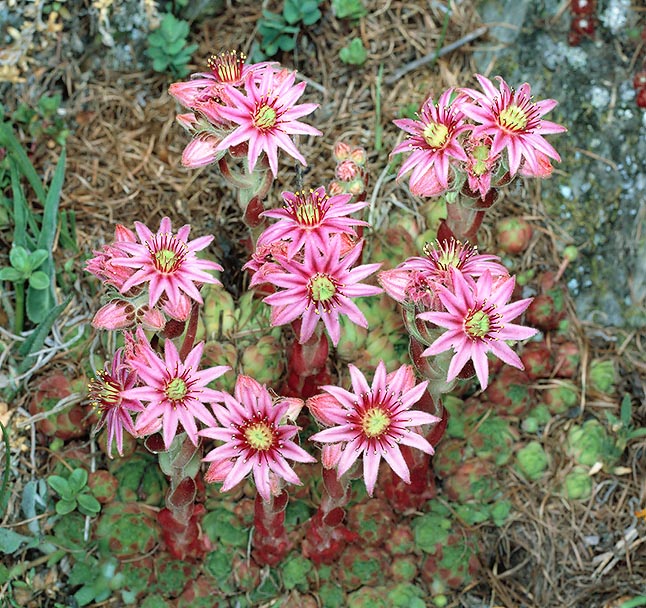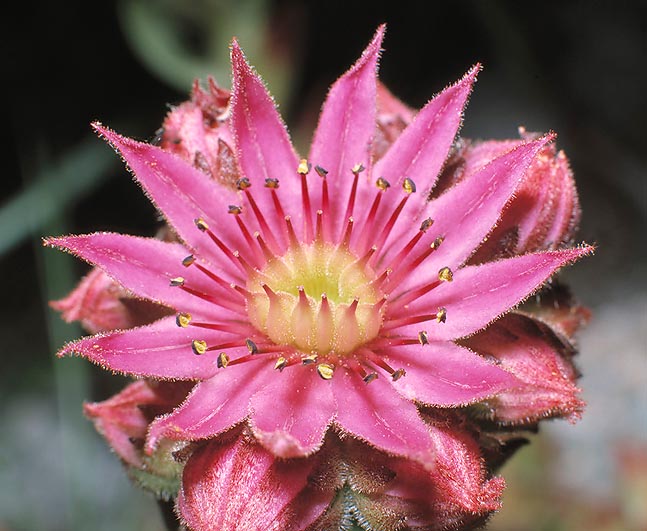Family : Crassulaceae

Text © Pietro Puccio

English translation by Mario Beltramini

Orophyte, up to 3.000 of height, the Sempervivum montanum is fit for mountain rock gardens © Giuseppe Mazza
The name of the genus is the combination of the Latin words “semper” = always and “vivum” = alive, with reference to the survival capacity in climatically hostile habitats; the name of the species is the Latin word “montanum” = mountainous, as it is a species living at high altitudes.
Common names: mountain hens and chicks, mountain house-leek (English); netřesk horský (Czech); joubarbe de montagne (French); guardacasa, semprevivo montano (Italian); rojnik górski (Polish); verzisoara de munte (Romanian); skalnica horská (Slovak); siempreviva de montaña (Spanish); Berg Hauswurz (German); молодило гірське (Ukrainian).
The Sempervivum montanum L. (1753) is a succulent, perennial, stoloniferous plant which forms compacts tufts, monocarpic (it flowers only once, then dies), with persistent succulent leaves, alternate, united in a thick basal rosette of 2-4 cm of diameter. The leaves are sessile (without petiole), oblanceolate, 1-2 cm long, of a green colour frequently with reddish shades on the extremities, ciliate margins and surface covered by glandular hairs emitting a strong scent of resin.
Summer inflorescences in terminal cymes on a 5-20 cm tall scape with 2 to 8 flowers of 2,5-4 cm of diameter, each one with 10-15 linear lanceolate petals, extended, pointed, 1-1,5 cm long, with a colour varying from purple pink to magenta with a darker central band. The floral scape is provided with lanceolate, imbricate leaves, 2,5-3,5 cm long, green with brown-red shades at the extremity and covered by glandular hairs. The fruits are follicles containing brown ellipsoidal seeds. After the fructification, as already briefly said, the rosette dies, replaced by the near ones. It reproduces by seed, and, very easily, by division.

The flowers may have a diametre of 4 cm. The seeds must stay 2 months in fridge for a good germination © Mazza
Quite appropriate name for a kind of plants capable to live advantaging of the little substratum which may be accumulated in the rocks, to bear strong winds, marked daily and seasonal sudden changes in temperature, from -30 °C to +50 °C, high humidity in spring, by the melting time, and summer dryness due to the intense insolation to which they are submitted.
Calcifugal plant, it is suitable for rock, alpine gardens, and for edges in full sun, on much draining substrata, but also for the cultivation in pot, at the maximum possible luminosity and with substrata with addition of sand or siliceous crushed stones up to the 50%.
It needs more humidity by the time of the vegetative renewal, in spring, and till mid summer, then regular watering, but always allowing the substratum to dry up for some days before irrigating again, then the watering are to be gradually reduced for reaching an almost complete suspension in winter. This plant has been variously utilized by the local populations in the traditional medicine, and, furthermore, when it was growing on the roof it was reputed to protect the houses from the thunderbolts and the witchcrafts. It is locally inserted into the lists of the protected species.
Synonyms: Sempervivum debile Schott (1852); Sempervivum monticolum Lamotte (1864); Sedum montanum (L.) E.H.L.Krause (1902).
→ To appreciate the biodiversity within the CRASSULACEAE family please click here.
